|
|
Post by badwolf on Jun 24, 2019 9:05:38 GMT -5
We've forgotten him already...
I dug out the issue and had another look. I don't know if I noticed before that Sue was sitting in a Mr. Fantastic hammock. If it was just that it would have been okay, but having the other Avengers standing around makes it weird.
I think the Layton image was used for The Many Armors of Iron Man, or something like that.
I like Brent Anderson's Ka-Zar & Shanna, with Zabu doing that thing cats do when you scratch them there. Cute.
Art Adams' FF, not bad but I find his earlier Marvel work just doesn't look that good to me any more, especially when compared to his current work.
Blevins' Hela as mentioned looks great.
Bogdanove's Volstagg and family, Breyfogle's Hulk, bleh.
J. Buscema's Loki, nice but typical.
Chaykin's Wolverine, nice enough.
Golden's Cap, spectacular.
Late 80s Avengers by Guice, see above.
Jason's Spider-Man, nice.
Kaluta's Kitty is nice but yeah it does seem like there's a story here.
Layton's Iron Man, okay but nothing special.
Jim Lee's Galactus & Surfer, fantastic.
Clealoha...err Clea by Leialoha, ok.
Leonardi Colossus good.
Mignola's Namor, great!
Kevin Nowlan's Dr. Strange, great! He did some covers for the modern Strange Tales, if I remember correctly, and finally got to work on Doc in Jason Aaron's recent run. Man I love Nowlan's stuff.
Scarlet Witch by Sandy Plunkett, very nice, though it seems like there was a story here too. She looks possessed and it surrounded by big cats, one of which is on fire. I wish Sandy did more comics work besides covers, pin-ups, and Handbook portraits.
Bill Reinhold's Dracula is fine.
Marshall Rogers' original X-Men, eh.
JRJR's Daredevil, bleh.
Rude's Black Panther is good.
PCR's Killraven is nice. Maybe they felt they had to put his name there or people wouldn't know who he was.
New Mutants by Terry Shoemaker, eh.
Magik by Bill Sienkiewicz WOW
Thor by Simonson, decent but unspectacular by his standards (and why is the Midgard Serpent brown?)
Green Goblin by Paul Smith, great!
Iron Man Grey by Steacy, nice and "arty."
Black Bolt & Medusa by Charles Vess is very pretty.
Rawhide Kid by Alan Weiss, ok.
Storm by BWS, ok.
Punisher by Zeck, nice. Lots of creator names hidden in the graffiti. Wonder who Dennis + Connie are...
Nude picture of Al Milgrom....priceless.
Even though most of the artist names are visible in the images, it's odd that there are no artist credits, only colorists.
|
|
|
|
Post by codystarbuck on Jun 24, 2019 12:39:55 GMT -5
Jackson Guice, surprise, surprise, does an exploitive piece of Sue Storm in a skimpy bikini, surrounded by Cap, Thor, Reed, and some other dude (I can't identify him), in their regular costumes. I had to look through my scans of all of those pin-ups; that's actually the post-#300 line-up of the Avengers, i.e., the Fantastics, Cap, Thor and - Gilgamesh the Forgotten One: ...sans his oh-so-excellent helmet.
I hadn't really noticed him at all, until about the third time I looked at the pin-up, for the write-ep. The focus tends to be on Sue's Fantastic 2. |
|
|
|
Post by codystarbuck on Jun 24, 2019 12:47:45 GMT -5
We've forgotten him already... I dug out the issue and had another look. I don't know if I noticed before that Sue was sitting in a Mr. Fantastic hammock. If it was just that it would have been okay, but having the other Avengers standing around makes it weird. I think the Layton image was used for The Many Armors of Iron Man, or something like that. I like Brent Anderson's Ka-Zar & Shanna, with Zabu doing that thing cats do when you scratch them there. Cute. Art Adams' FF, not bad but I find his earlier Marvel work just doesn't look that good to me any more, especially when compared to his current work. Blevins' Hela as mentioned looks great. Bogdanove's Volstagg and family, Breyfogle's Hulk, bleh. J. Buscema's Loki, nice but typical. Chaykin's Wolverine, nice enough. Golden's Cap, spectacular. Late 80s Avengers by Guice, see above. Jason's Spider-Man, nice. Kaluta's Kitty is nice but yeah it does seem like there's a story here. Layton's Iron Man, okay but nothing special. Jim Lee's Galactus & Surfer, fantastic. Clealoha...err Clea by Leialoha, ok. Leonardi Colossus good. Mignola's Namor, great! Kevin Nowlan's Dr. Strange, great! He did some covers for the modern Strange Tales, if I remember correctly, and finally got to work on Doc in Jason Aaron's recent run. Man I love Nowlan's stuff. Scarlet Witch by Sandy Plunkett, very nice, though it seems like there was a story here too. She looks possessed and it surrounded by big cats, one of which is on fire. I wish Sandy did more comics work besides covers, pin-ups, and Handbook portraits. Bill Reinhold's Dracula is fine. Marshall Rogers' original X-Men, eh. JRJR's Daredevil, bleh. Rude's Black Panther is good. PCR's Killraven is nice. Maybe they felt they had to put his name there or people wouldn't know who he was. New Mutants by Terry Shoemaker, eh. Magik by Bill Sienkiewicz WOW Thor by Simonson, decent but unspectacular by his standards (and why is the Midgard Serpent brown?) Green Goblin by Paul Smith, great! Iron Man Grey by Steacy, nice and "arty." Black Bolt & Medusa by Charles Vess is very pretty. Rawhide Kid by Alan Weiss, ok. Storm by BWS, ok. Punisher by Zeck, nice. Lots of creator names hidden in the graffiti. Wonder who Dennis + Connie are... Nude picture of Al Milgrom....priceless. Even though most of the artist names are visible in the images, it's odd that there are no artist credits, only colorists. Plunkett's appears to be related to the earlier Scarlet Witch story, in Fanfare. Killraven looks like a promotional image repurposed for this, hence the logo. I'm kind of betting the same for Layton's. Chaykin did a far better Wolverine in his Nick Fury/Wolverine GN. That one had me wondering what was up with his face. |
|
|
|
Post by chaykinstevens on Jun 24, 2019 16:18:30 GMT -5
The letters pages are filled with suggestions for characters to feature in the Magazine, including Black Knight and Moon Knight, both who will appear in future issues; and, one that I thought made perfect sense, Deathlok. I don't remember Black Knight turning up, although one issue featured Merlin by Doug Moench and John Buscema. |
|
|
|
Post by MWGallaher on Jun 24, 2019 20:07:11 GMT -5
Marvel Preview #4The letters pages are filled with suggestions for characters to feature in the Magazine, including Black Knight and Moon Knight, both who will appear in future issues; and, one that I thought made perfect sense, Deathlok. Imagine Deathlok in a non-Code magazine comic........apparently, Marvel couldn't (or wouldn't). Really, the magazine line was in dire straits, or at least nearing them. The recession wasn't helping things and they were axing a lot of them. This series continued and they did launch a few more, after axing others to make room. This one had a longer life than others. Marvel did seem to have some high ambitions for the B&W magazine line. I was just looking at an issue that was offering subscriptions to several never-to-be-published-under-their-own-name titles: Thor, Star Lord, and Sherlock Holmes, all of which ended up in Marvel Preview, obviously (the second issue of Thor the Mighty turned up in a color annual). The Bullpen Bulletins hinted that Godzilla was to be published in that format. As much as I love the color comic, I'd love to have seen the Big G in the B&W line, with some painted Bob Larkin or Earl Norem covers, maybe with an It! The Living Colossus backup. It makes me dream of what a fully successful Marvel Magazine line might have been like...Deathlok and Black Knight would certainly have been welcome entries. I'd prefer conventional superheroes like Spider-Man, FF, Iron Man, Captain America to keep their distance, but I could see Dr. Doom and the Sub-Mariner sharing a B&W book that might work a lot better than Super-Villain Team-Up did, with European-based Doom stories and underwater fantasy in Atlantis rather than the NYC-centric typical Marvel Universe stuff. Ghost Rider could work, and hey, why not a Mighty Marvel Western with a longer, cinematic approach to the stories? War Is Hell might work better on the code-free magazine rack, including not just John Kowalski's Twilight Zone-ish exploits, but reviving some of Marvel's moribund battle comic trademarks like Combat Kelly (which would be more amenable to a 70's upgrade than the firmly established but unconvincing Sgt. Fury). And hey, maybe Killraven would have fared better in this parallel universe in a B&W mag, pared with, maybe, Skull the Slayer as a backup, only more consistently hewing to the original premise this time? |
|
|
|
Post by codystarbuck on Jun 24, 2019 23:06:07 GMT -5
The letters pages are filled with suggestions for characters to feature in the Magazine, including Black Knight and Moon Knight, both who will appear in future issues; and, one that I thought made perfect sense, Deathlok. I don't remember Black Knight turning up, although one issue featured Merlin by Doug Moench and John Buscema. I think I confused the Merlin one, based on one of the editorial pages saying Black Knight was to be down the road, in response the various suggestions from fans. |
|
|
|
Post by codystarbuck on Jun 26, 2019 15:50:13 GMT -5
Marvel Preview #5 The House of (Other People's) Ideas!  This is the first of two issues devoted to Sherlock Holmes. As Archie Goodwin says in the editorial, Holmes was going through a period of increased popularity. Nicholas Meyer's meeting of Holmes and Sigmund Freud, The Seven Per Cent Solution, was a bestseller, and Gene Wilder was starring in the spoof, Sherlock Holmes Smarter Brother (which is not Mycroft, in this film, which screwed me up in Scholastic Bowl, thank you very much!). There were several Holmes pastiches in the 70s. Holmes hadn't had many adaptations, in comics, at this point, other than Classics Illustrated and a few guest spots, in things like Batman. It seemed nobody had enough faith for an entire Holmes series, either adapting the stories or creating new ones, until the 80s, with things like Scarlet in Gaslight, and in Baker Street, where Holmes got a punk makeover, by Guy Davis. Archie doesn't state as such; but, I thought I remember reading that Marvel had originally intended to have a Holmes magazine and the material got folded in here, instead. Haven't been able to confirm that. Creative Team: Sir Arthur Conan Doyle-writer, Sydney Paget-illustrator, Doug Moench-script, Val Mayerik-art, inspired by Paget, Archie Goodwin-editor, John Warner-assist. editor, Marv Wolfman-consulting editor (fitting title, for a Holmes magazine). The Consulting Editor credits in these issues seem to suggest who was editing when the project began. Marv was running the magazine line, before being bumped to EIC (when Len abandoned it) and he gave way to Archie, after Conway crashed and burned too fast to really touch the magazines. That suggests, to me, that this material was intended for a Holmes magazine. This is part one of an adaptation of The Hound of the Baskervilles, about a neighbor's dog, who won't stop howling, at night. I think. I just skimmed the cover of the Cliffs Notes. Synopsis: (please imagine this as being narrated by Nigel Bruce) Holmes is sitting at the breakfast table, while Watson examines a walking stick. Holmes prods him to make deductions, then corrects him, like a big old smarty pants (my description; Watson would say something about Holmes presenting an alternate theory, wot?). After Mr Know-It-All rubs Watson's face in it, the visitor comes back to visit the consulting detective. he is James mortimer, late of Charing Cross Hospital, who has since retired to Devonshire, to start a consulting practice, upon his marriage. One of his patients was Sir Charles baskerville, who seemed to expect to come to a gruesome end. He reads Sir Charles' description of his ancestor, Hugo Baskervilles, who was a wicked man, who kidnapped a maiden and held her prisoner, while he conducted orgies with his friends. The woman escaped down the side of the house on vines and ran across the moors. Upon discovering her missing, Baskerville rode with a pack of hounds to find her. A witness saw Baskerville riding for his life and the evil howling of a big black hound. Later, the woman was found dead and Baskerville was dead, with a black hellhound nipping at his torn throat. From then on, the Baskervilles were a cursed family. 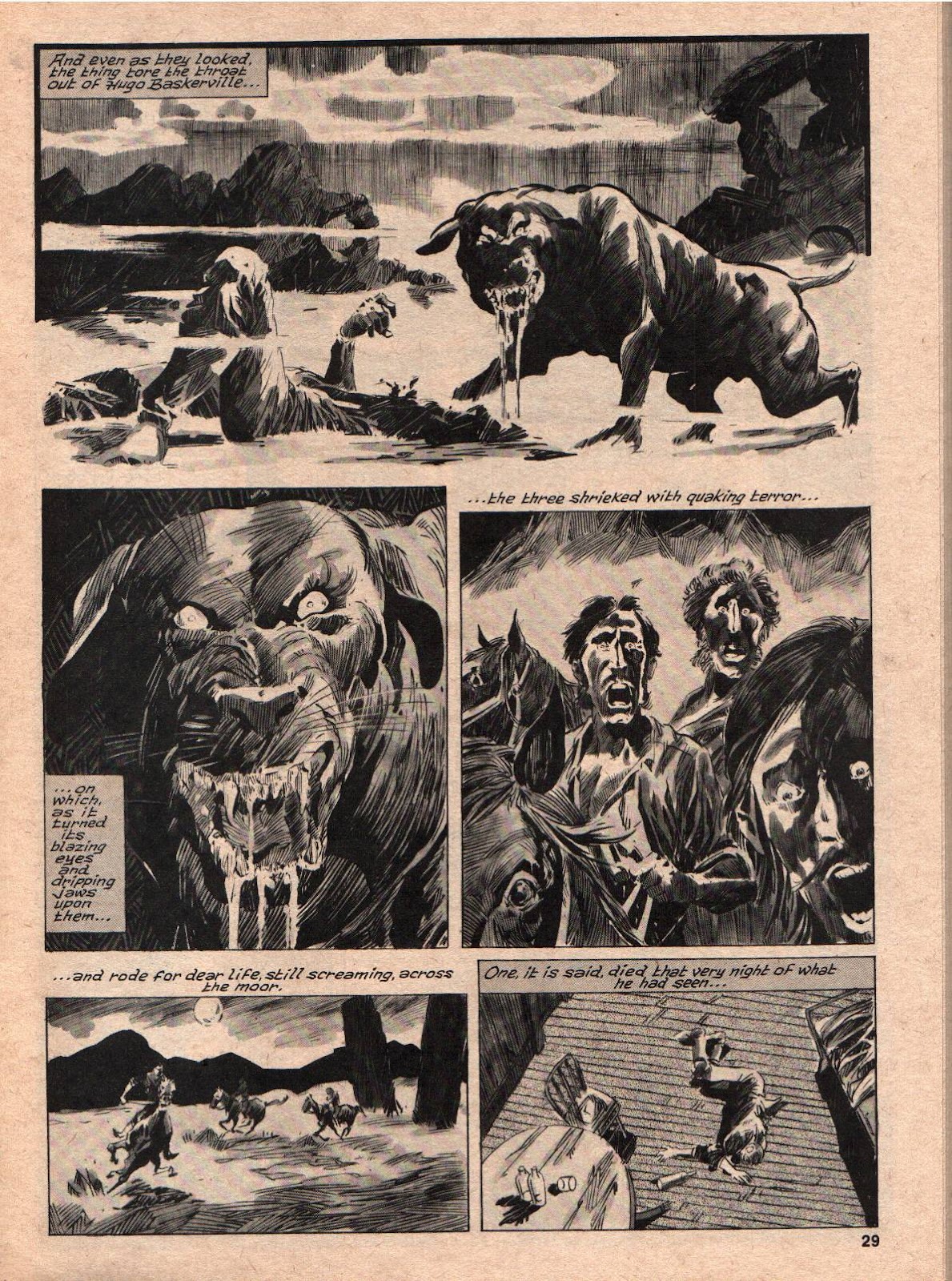 Holmes doesn't think much of the legend. Mortimer continues. Sir Charles earned his fortune in South Africa and returned to the family home, to restore it and institute improvements to the area. however, he became increasingly affected by the legends. On his final night, he went out on his walk and was found dead, in the moors, of an apparent heart attack; but with a face stricken in terror and the footprints of a large hound nearby. Mortimer is left to believe there might be a supernatural connection to Sir Charles' death, despite being a man of science. Holmes is less convinced. Baskerville's nephew, Henry, is the inheritor and is arriving there to live. mortimer worries for his safety and Holmes agrees to take on the case. Holmes is introduced to Sir Henry, the heir and presented with a warning letter that Sir Henry received. Holmes deduces that it was clipped from the Times and produces the article from which it came.. 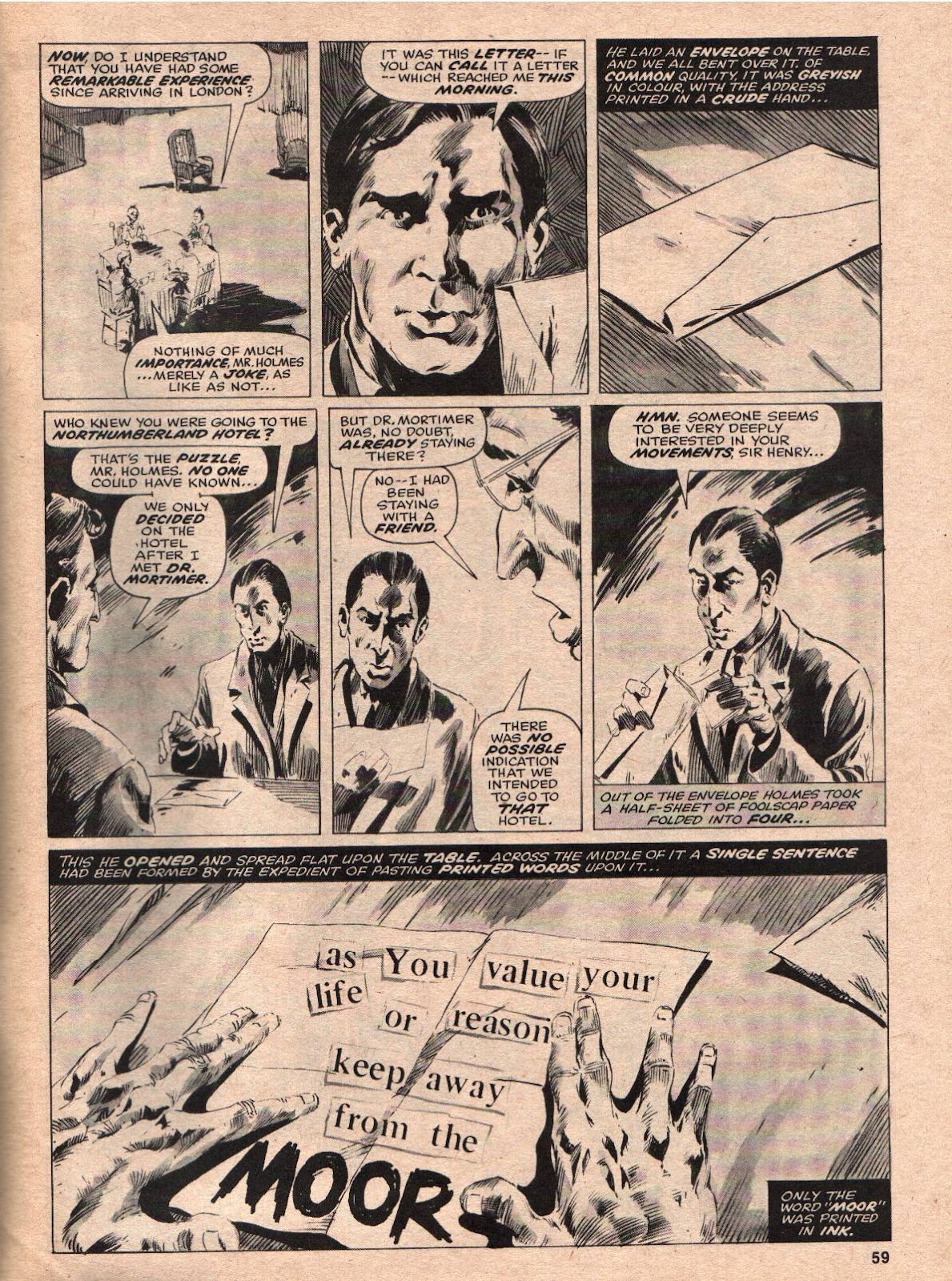 The word "moor" is printed by hand and Holmes deduces, based on the clipped words coming from the Times, that the writer was an educated person, trying to disguise the fact in the style of printing. Holmes is intrigued and the issue ends. Thoughts: Moench very much sticks to the original work, right down to extended scenes of the characters in conversation. Mayerik provides very fine and detailed art; but, it's hard to convey much excitement, across the pages, with scenes of talking heads. the story of Hugo Baskervilles lets Mayerik play some action; but, then we are back to the talking heads (minus David Byrne). if anything, Moench may be too faithful to the source, trying to convey too much of it in the work, rather than adapting it more to a visual medium. This more than anything is why Holmes hasn't been as heavily represented in comics as others. The stories involve much of these types of scenes, which read better in prose than in something visual. It is for these reasons that film and tv tend to jazz up Holmes, though the Jeremy Brett series did a fine job of striking a balance. Mayerik's Holmes looks rather like Peter Cushing, who starred as Holmes in the 1965 BBC tv series of adaptation, with Nigel Stock as Watson. Mayerik's Watson seems a bt more generic, at times suggesting Nigel Bruce; and, others, Stock. At other times, he is less defined. The Cushing series did a fine adaptation of The Hound, and Cushing had already played Holmes in the Hammer adaptation of The Hound of the Baskervilles (with Andre Morell as Watson and Christopher Lee as Sir Henry Baskervilles). The depiction of Sir Hugo brings to mind the Hellfire Club, in both the historic form and as seen in the Avengers tv episode, "A Touch of Brimstone," which inspired the X-Men version. About the only thing missing is Diana Rigg in a corset, spiked collar and leather knee boots and opera gloves (sometimes hard to remember that crafty and sharp-tongued Lady Olena was also the super sexy, fetish-attired Emma Peel). As an adaptation of Doyle, it captures the tone of voice of the author and the work. As a comic work, it is rather static and a touch on the dull side. Part two will present more opportunities for action, as the first part requires a lot of exposition. The letters pages talk about Starlord and the general consensus is favorable, though Quill is a jerk. One writer thought Sword in the Star was the better feature; the rest barely mention it. Ken Barr did the evocative cover painting, while frank Thorne did an interior illustration of Holmes and Moriarty, at Reichenbach Falls and the accompanying illustration of Holmes & Watson, on a Victorian street, with Archie's editorial.
|
|
|
|
Post by codystarbuck on Jun 26, 2019 17:17:13 GMT -5
Marvel Preview #6 "I say, Holmes; bally flimsy nighty on that young woman. I shall examine her....er, hrm, for medical evidence." "Oh, was she a woman? I hadn't noticed. Women don't seem to interest me much in these things, Watson." Creative Team: same bunch, with Tony Dezuniga contributing to the art. Synopsis: Sir Henry Baskerville returns to his hotel, shadowed by Holmes & Watson, who spy another....er, spy, shadowing Sir Henry. The spy spies their spying of said spy and spides....speeds away. Homes & Watson doing some digging then go to Sir Henry's hotel, where he is terrifying staff over missing boots. he has had a brown and a black boot go missing, though just the one each. Holmes tells him of the spy and they later meet the cabbie, who says the man claimed to be a detective and paid him 2 guineas to do what he wanted, for the day, then suddenly had him drive him to Waterloo station and not to spare the hore. he then said the man claimed to be Sherlock Holmes. 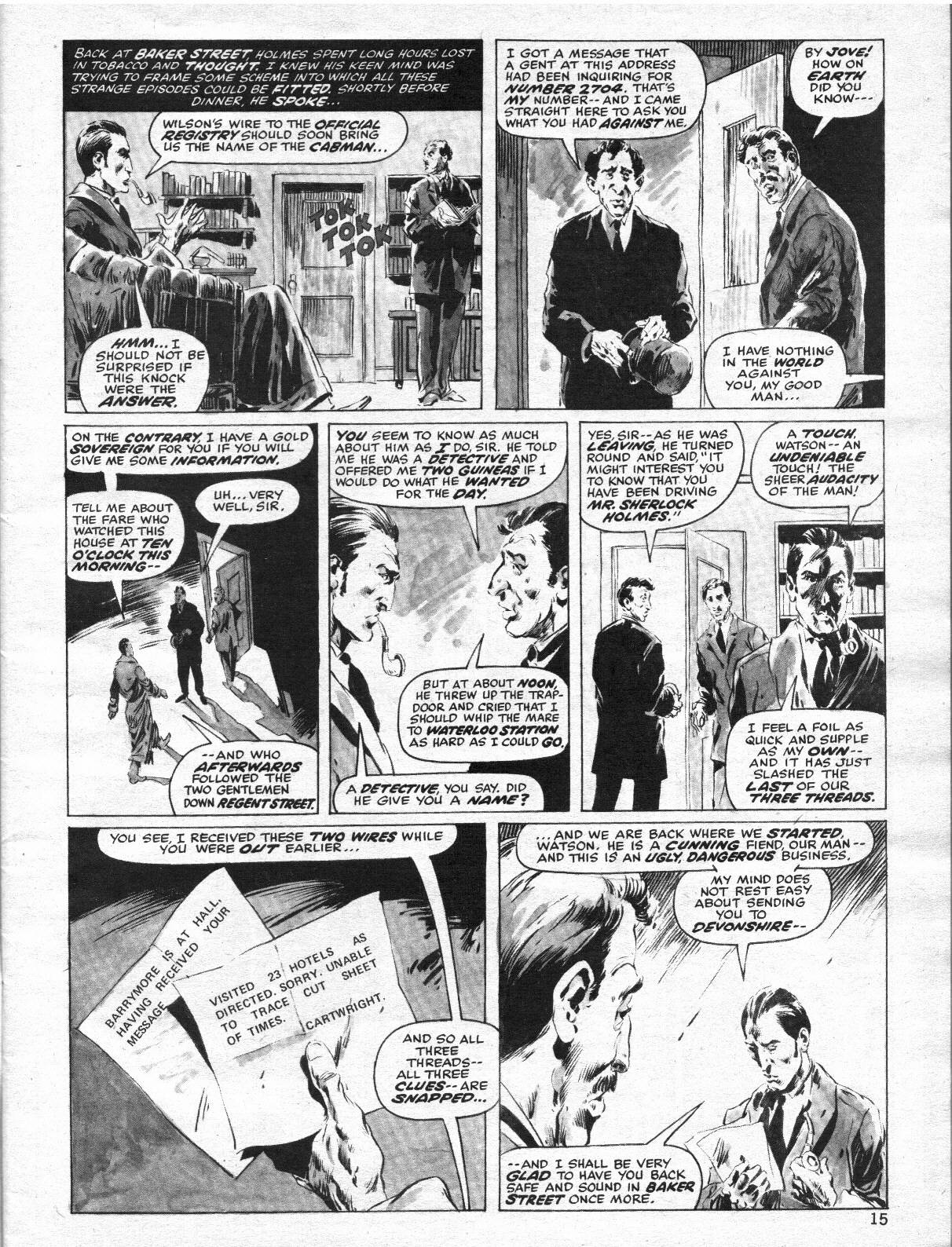 Holmes sends Watson to accompany Sir Henry to Dartmoor, where he will act as protector and send updates to Holmes, while he continues on another case. Watson travels with Sir Henry and Dr Mortimer and they run into a soldier, at a roadblock, in Devon. they are looking for the escaped Notting Hill murderer, Hugh Grant, I mean Selden. They travel on and arrive at Baskerville Hall, where they meet the Barrymores, the servants, who Holmes has already suggested as possible suspects, with much to gain if Sir Henry were out of the way. However, they talk of leaving the home, permanently. That night, Watson here's the sound of a woman sobbing, but it was not repeated. The only women in the house were a scullery maid, who slept on the other side of the house, and Mrs barrymore, whose husband assured Watson was not weeping in the night. Watson isn't sure he believes Barrymore. He goes to the village to check about a test telegram that Holmes sent and finds that it had been delivered to mrs Barrymore. He goes walking in the moor and runs into Stapelton, the natuarlist, who talks about the dangers of the moor, as a pony has become caught in a quagmire. Stapleton goes off, bounding across sound turf, chasing butterflies, while his sister warns away Watson. It turns out she thought he was Sir Henry and later tells Watson her warning didn't apply to him. 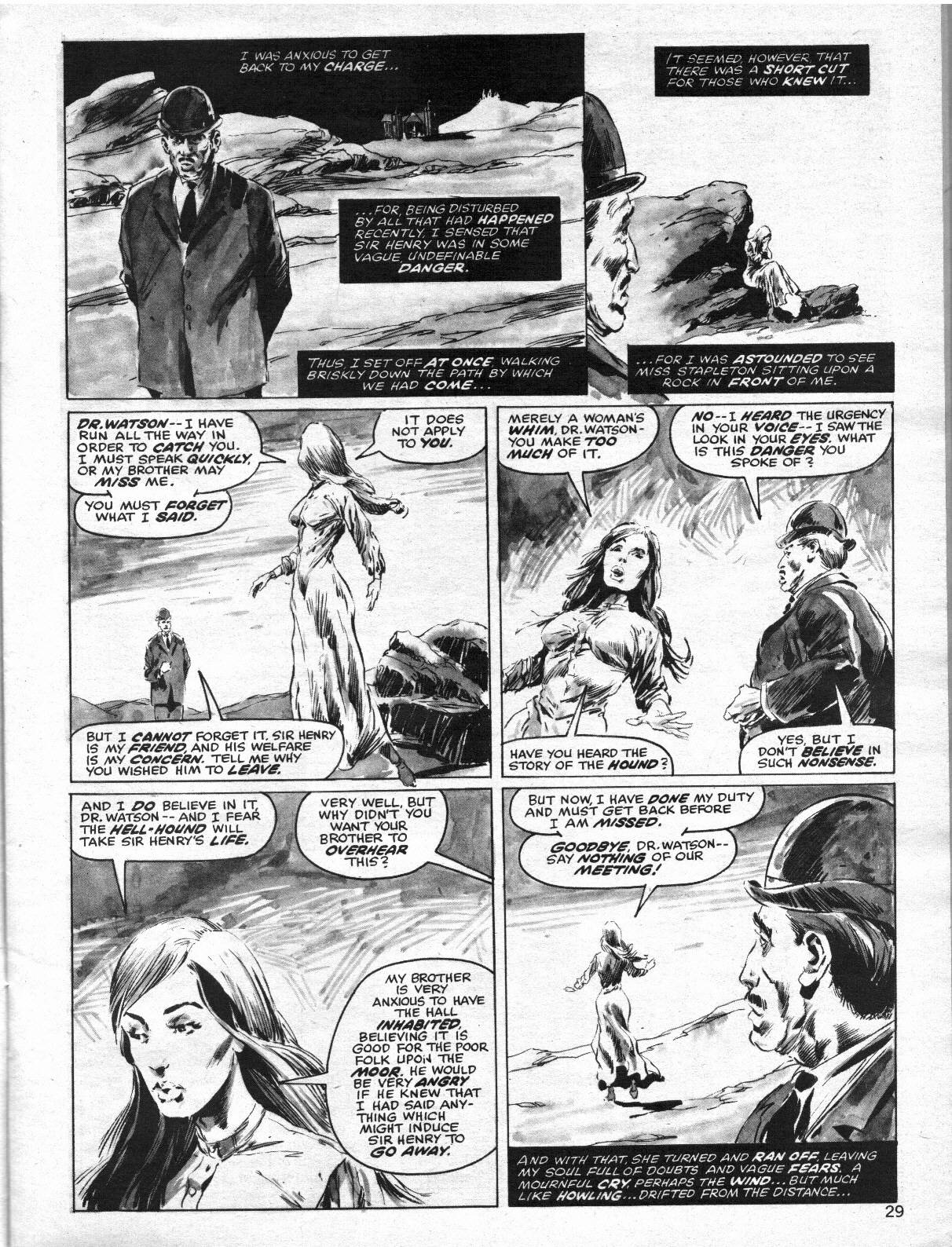 Watson files his report to Holmes, telling of the Stapletons dining with Dr Mortimer, Watson and Sir henry and how taken Sir Henry was with the female Stapleton. Her brother seemed upset at his attention. He later meets Mr Frankland, an old der neighbor, who is an amateur astronomer. He questions Barrymore about the telegram and sees signs of Mrs barrymore had been crying again, as Watson had believed. He later observes Mr Barrymore standing, with a lamp, at a window, during the night, then let out an audible groan, before moving on. Watson discusses things with Sir Henry and both believe he was watching for something. Sir Henry goes to walk in the moor and insists Watson not accompany him, so he sneaks after him and spots him meeting Miss Stapleton. he seems to implore her and she pull away, when they are interrupted by the brother, who reacts angrily. Watson catches up with Sir Henry, who admits to proposing marriage to the lady and being rejected and warned to leave. Watson and Sir Henry observe Barrymore at the window again and spot a light in the moor. they investigate and finds barrymore and his wife; but miss the man they are meeting. they admit it was selden, the escaped convict, who is Mrs barrymore's brother, who is hiding there, starving. He signaled for food. They assure him he had nothing to do with Sir Charles' death. Later, Mr Frankland has spotted the escape convict, or so he thinks. Watson tracks the man to his lair and discovers it is Holmes, who camped out to watch in secret. he informs Watson that Stapleton's sister is actually his wife. She was used by her husband to get close to Sir Henry, though not allowed to get romantic with him. She sent the clipped warning. Their reunion is interrupted by screams and they race to find a body, savaged by a hound... 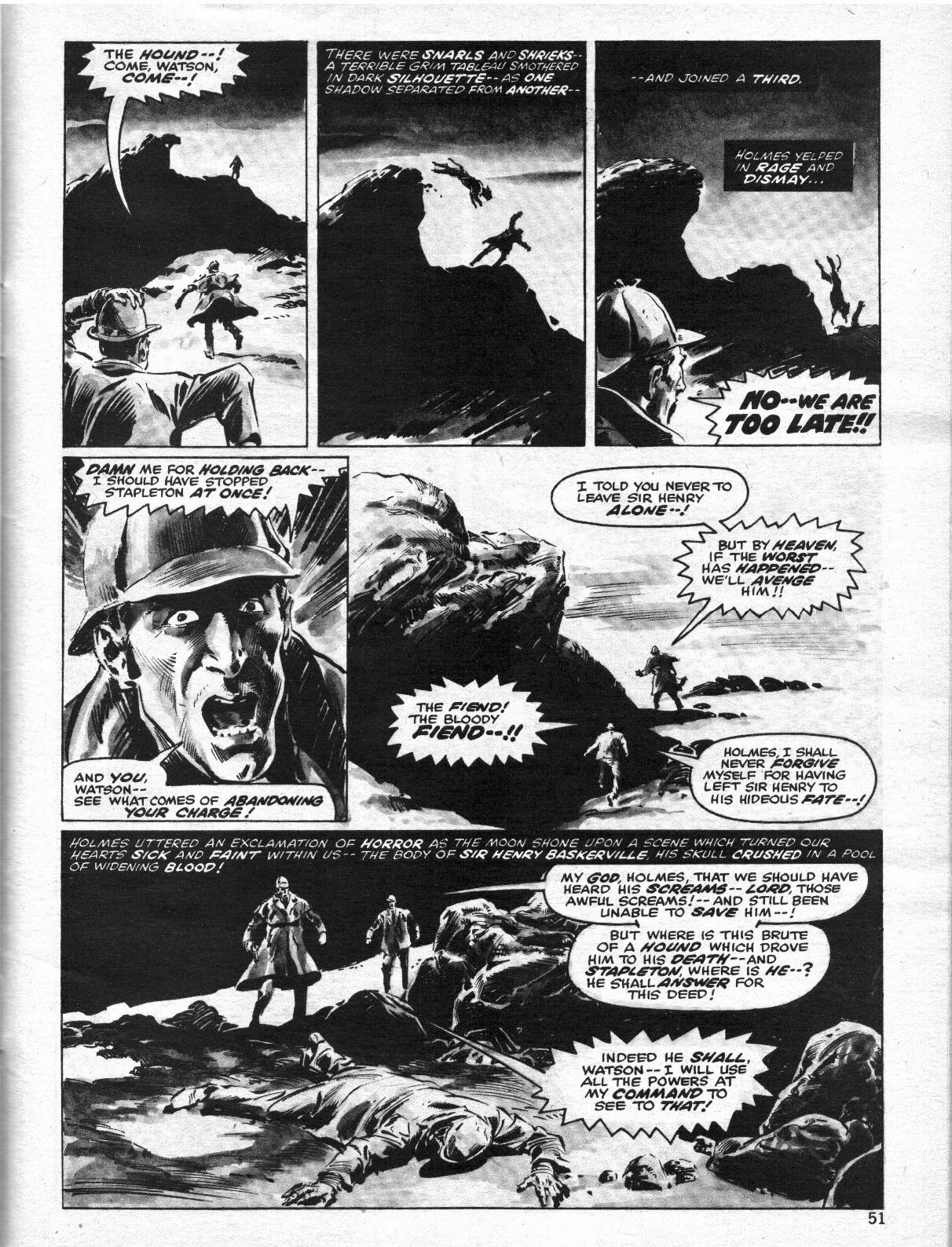 They believe it is Sir Henry and Stapleton turns up, also believing it is Sir Henry, when the light reveals it is Selden, the convict, in Sir Henry's clothes, obviously given him by the Barrymores. Holmes, at Baskervilles Hall, determines the truth of Stapleton's identity, does some further examining of evidence to establish the truth of it, then brings a reckoning to the moor and the Hound. Thoughts: Again, lots of talking heads; but, much more action to liven things up a bit, plus some delightfully horrific imagery fro the night moors and hellhounds. I won't fully give way the ending, though the novel is well known. Again, the pace is a bit slow and things probably could have been condensed a bit. Mayerik's storytelling needed some creativity to keep the exposition lively. The story itself captures the novel quite well; but, the technical side lets it down, a bit. It wasn't quite as likely to launch a Holmes series, if that was the intent. As a literary adaptation, it is quite good and more lively than a Classics Illustrated. As a reular series, it could use a bit more adrenaline. Archie informs us that Dezuniga is there to help Mayerik with the deadline, taking over the inking (apart from 2 pages done by P Craig Russell). If you are a Holmes fan, you will probably enjoy this. if you have never read the novel or any of the stories, it serves as a fine introduction to Holmes. However, Holmes has been adapted to comics in far better manners. Scarlet in Gaslight pitted Holmes against Dracula in a Victorian detective/horror adventure, which was faithful to the spirit of both works, while carving out a new story. Meanwhile, Gene Day's brothers adapted some of the Holmes stories in far more engaging and lively manner. Scarlet was published by Malibu, who also put out reprints of Frank Giacoia's comic strip version. The Day material was published by Renegade Press. Guy Davis' Baker Street was done at Caliber, in a style that predates Sherlock by about 20 years. It's not exactly like Sherlock; but, is a modern take on it, though with a punk aesthetic. All in all, these two issues present a writer-driven take on Holmes, with the text of Doyle playing a more important part, though Mayerik does a credible job of capturing the atmosphere of the story. He isn't quite as detailed as he could have been; but, the level of text needed room in the art, necessitating a loss of details. That is a point for which he is taken to task, by one letter writer, for the first issue. he doesn't fully capture the period, either; but, probably did so enough for the average reader. The letters pages are mostly praiseworthy of part 1, apart from some minor nitpicks. There is one unrelated letter suggesting a more mature version of Spider-Man, for Marvel preview, which is deemed unnecessary, in the editorial response. Marvel did 2 issues of The Spectacular Spider-Man, in 1968, as a test of the waters, for invading Warren's territory. The issues featured Lee and Romita stories, which were later reprinted, in edited form, in Amazing Spider-Man. Not sure about sales, though Roy Thomas has said Martin Goodman wasn't keen on doing comics on the magazine stand and didn't support the idea (and didn't want potential issues with the Code, over doing non-Code comics). The magazine line was launched (relaunched, really) after he sold Marvel to Cadence Industries. I wouldn't have minded more Holmes, with a better balance of story and art, capturing the spirit of Doyle, if not exactly the words. I also think there was more to be gained by doing new stories than just adaptations.
|
|
|
|
Post by codystarbuck on Jun 26, 2019 17:19:38 GMT -5
ps We are told that Titan, the Roy Thomas and Rich Buckler adaptation of Phillip Wylie's Gladiator, is next; but, like Thor, that will prove to be wrong. Instead, we get Satana. Cool; I love his music!  |
|
|
|
Post by codystarbuck on Jun 27, 2019 17:09:07 GMT -5
Marvel Fanfare #48 Creative Team: Creative Team: Dwight John Zimmerman-writer, Kerry Gammill-pencils, Josef rubinstein and Jose Marzan-inks, Morelli-letters, Neil Yomtov-colors, Al Milgrom-edits. This was supposed to be an all-She-Hulk issue; but, Byrne bowed out after he was off the main She-Hulk comic. So, we get two She-Hulk stories and one from the Vision. Al's Editori-Al covers his dilemma and notes that the Vision's costume was now white, in WCA; so, he can't even go with a color scheme (though Viz is in green and yellow, here). Synopsis: She-Hulk is in California to be a celebrity judge at a bodybuilding competition. She runs into her father, the sheriff, and has to inform him she is stuck as She-Hulk. He doesn't see She-Hulk as Jennifer Walters and basically disowns his daughter...   Turns out there is a mini-family reunion, as her unknown aunt is also there and has turned her son (Jenn's cousin) into a steroid freak, called Brawn, to get revenge on Jenn's dad, 'cause Dad liked him best. uh-hunh. Brawn shows up in the competition, attacks his cuz, gets shot by his uncle, who reconciles with his daughter, while nephew hops away with his mom.    Thoughts: Thoughts: Meh......Dealing with the past and family is a nice idea; but this is a mess that goes all over the place and the aunt is just plain silly. She also hates abstract art. Even Stan would have though that was corny. "California Dreaming"Creative Team: Sue Flaxman-writer, Don Perlin-pencils, Jim Novak-letters, Bob Sharen-colors Synopsis: She-Hulk is contracted by some old friend we have never met, in a dream and goes to aid him and fights some corporate goon, in a dream world, as jennifer Walters, since the dude is psychic...    Thoughts: Thoughts: Double meh.............The point of these two stories seems to be reaffirming that She-Hulk is Jennifer Walters; but, it made for less than compelling stories, in both instances. The first one is better with the father-daughter bit; but, too short to do the idea justice. This seems more random. Run Through The JungleCreative Team: Michael Higgins-writer, Ron Wilson-pencils, Jim Sanders III-inks & colors, Jim Novak-letters Synopsis: The Vision still believes he is the Human Torch, in updated form and has "memories" of flash-frying Hitler. He is flying over a forest and runs into a psychic wall, causing him to crash.  He encounters a Vietnam vet who is having flashbacks, dealing with the death of a buddy, who is killed when he chased after the vet, after he shot up with heroin, in the jungle. He sees the Vision as the buddy and thinks he is a ghost, then his family finds him and he thinks they are Vietnamese villagers.  Vision blocks him and then phases his hand into the vet's head and fixes his brain, releasing him from the visions.  Thoughts: Thoughts: the Vision seems an odd character for this type of story and the psychic element is never really explained. Does the vet have a mental power or is the Vision now psychic? It isn't clarified. It just comes across as yet another story of a PTSD Vietnam vet. I have no idea of Higgins' background; but, given the time frame for his credits, I would think he was too young to be a Vietnam vet. This story might have had more impact from a Doug Murray, Larry Hama, Mike Grell, or Don Lomax. None of these stories is particularly memorable and I doubt they would have been published in the regular series or as a one-shot, had not Fanfare been a dumping ground for material (certainly by this point of its life). The art is fine; but, the level of writing isn't exactly A-List or even B-List.
|
|
|
|
Post by MWGallaher on Jun 27, 2019 17:23:33 GMT -5
Marvel Preview #5 Archie doesn't state as such; but, I thought I remember reading that Marvel had originally intended to have a Holmes magazine and the material got folded in here, instead. Haven't been able to confirm that. From Marvel Preview #3, we see that Marvel was (prematurely) offering subscriptions to Thor the Mighty, Starlord s (sic), and Sherlock Holmes. They had prepared at least two issues of Thor and Holmes, and we got a run of four issues of Star-Lord in Marvel Preview, so that had probably been in the works the longest. Subscribers would be disappointed to get only one issue of Legion of Monsters, not six, and only three of Kull and the Barbarians. But at least Savage Sword of Conan proved to be a safe investment of $6.50!  |
|
|
|
Post by codystarbuck on Jun 27, 2019 17:48:53 GMT -5
Marvel Fanfare #49 Creative Team: Creative Team: Story and art by Alan Weiss, LP Gregory-letters, Greg Theakston-colors, Al Milgrom-edits Alan Weiss doing a western? YEEEEEEEEEeeeeeeeeeeeeHHHHHHHHHHHHHAAAAAAAAAAAaaaaaaaaaaaaaaaaaaaaaaaaaaWWWwwwwwwwwwww!!! Synopsis: Nick Fury and Dum-Dum Dugan have been drawn to dr Strange's Sanctum; but, rather than find a threat, they find Wong, acting very stereotypically...   Dr Strange left a spell to bring them to him and give them the right look, as they time hop to the Old West. there, they find Doc dealing with some owlhoots who think he is a card sharp. Doc Strange magics the varmits guns; but gets a spitoon to the noggin, before Fury and Dum-Dum arrive, and Dugan opens fire with a Thompson submachine gun. he then smashes up the bar with the onry cayute's faces...  Doc is okay and wakes up and explains things to Fury and Dugan. There is a rift in the time stream, caused by a Native shaman, called Redblade. he intends to creatw an army of magic warriors to attack the whites. Doc says it will, at best, extend the Indian Wars to WW1 and lead to total genocide, as airplanes and machine guns will be employed to totally destroy them. They set off to stop Redblade.  Doc tracks them psychically and they catch a warrior, who points the way. They interrupt the ceremony and Doc and Redblade face each other in a battle of magic, one upping each other's spells...   Redblade turns into a wolf creature and Doc shoot shim with his Remington, causing him to revert form. he is alive and Doc addresses the assembled, basically telling them they are Fed and to use their hearts to survive what is to come. Turns out that Doc shot him with a gold bullet, which is pure enough to defy magic (and avoid a trademark infringement suit). The job done, Doc, Fury and Dum-Dum ride off into the sunset. Thoughts: The story is a bit wonky and Doc's sentiments come across as a bit troublesome, given the actual history; but, it's a fun story. The troublesome is that it sounds like White Man's patrony, rather than real logic and inspiration. The art is fantastic and Weiss knows his western stuff. He bases his Doc on Errol Flynn, who did many a western and Fury on John Wayne, especially as Rooster Cogburn. Dum-Dum seems like an amalgam of Victor McLaglen and Alan Hale Sr, depending on the angle. Basically, a sidekick to Flynn or Wayne.  Two Guns Against the GangCreative Team: Two Guns Against the GangCreative Team: Mike Barr-writer, Tod Smith-art, Bill Oakley-letters, Paul Becton-colors Synopsis: Matt Hawk gets an outlaw acquitted of a crime and the townspeople aren't happy. The judge invites him to supper but they are ambushed by the outlaw's gang. The judge tells them that their boss is going free; but, they want him framed for murder, so Bear Bronson can take over. They have a necktie on the judge, when Hawk gets loose and changes into the Two-Gun Kid, takes out the gang, shoots the noose and frees the judge (as Matt Hawk again). They thus have complete proof that the outlaw, redlin, was framed.  Thoughts: Thoughts: Very slight story that needs more room to set up a proper mystery. The dual identity thing doesn't really work well in this short space of time. Bar is a good mystery writer and culd have done better, with more room. Not sure he is the best for a western, though.
|
|
|
|
Post by codystarbuck on Jun 27, 2019 18:00:08 GMT -5
Here is the most distinct look at Dum-Dum's face, in the story... 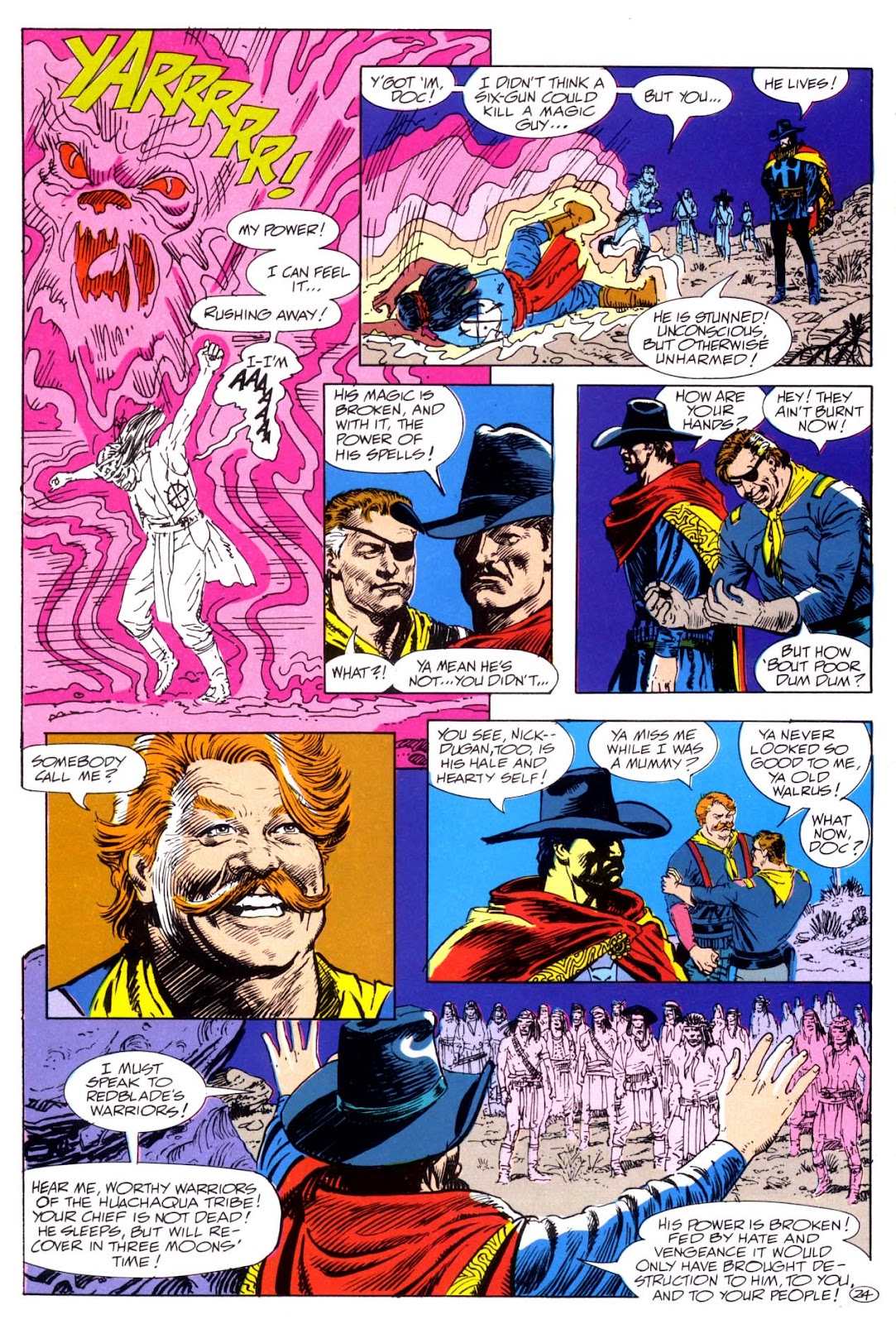 Given the nature of this, McLaglen and Hale Sr are the two actors who most come to mind, spiritually and physically. McLaglen...  Alan Hale Sr.... 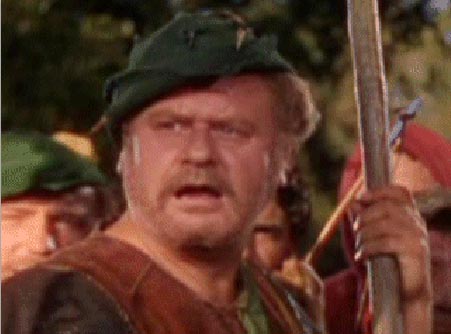 Maybe a little Ward Bond...  |
|
|
|
Post by profh0011 on Jun 27, 2019 21:14:50 GMT -5
For more SHERLOCK HOLMES comics... TESORO DE CUENTOS CLÁSICOS #86Editorial Novaro / Mexico / Oct'64 " The Red-Headed League" 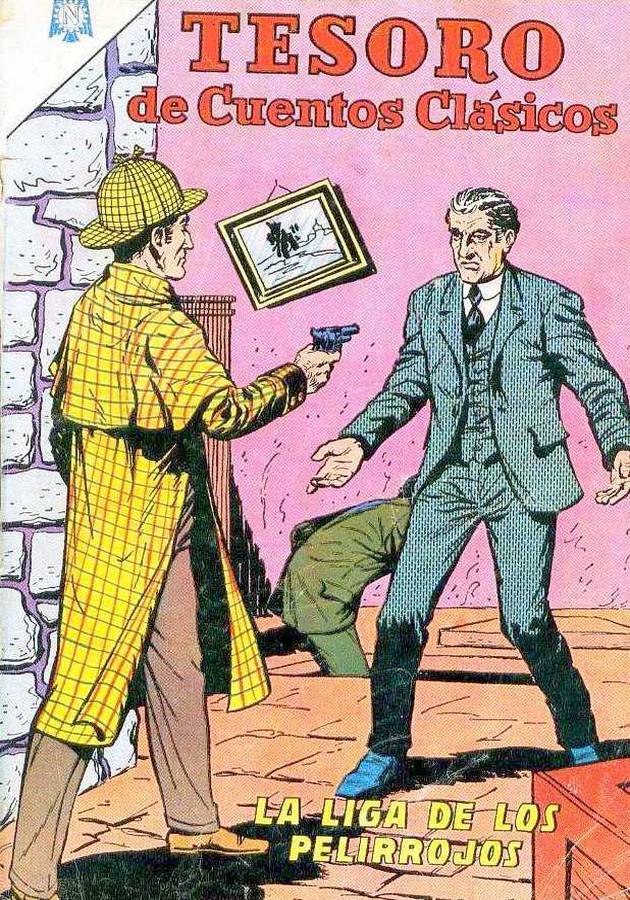 TESORO DE CUENTOS CLÁSICOS #90 TESORO DE CUENTOS CLÁSICOS #90Editorial Novaro / Mexico / Feb'65 " A Study In Scarlet" 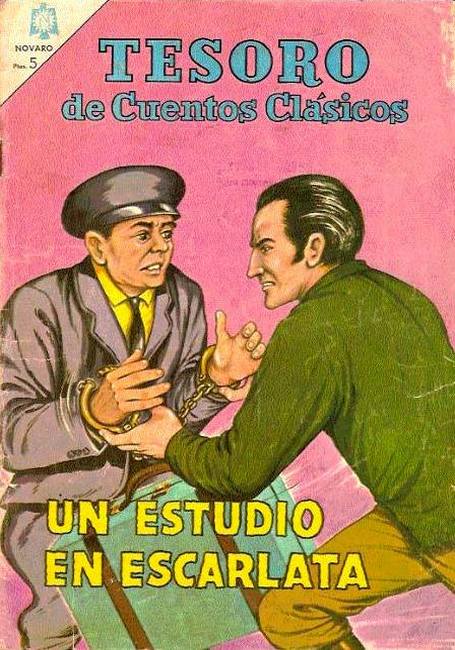 TESORO DE CUENTOS CLÁSICOS #91 TESORO DE CUENTOS CLÁSICOS #91Editorial Novaro / Mexico / Mar'65 " The Sign of The Four" 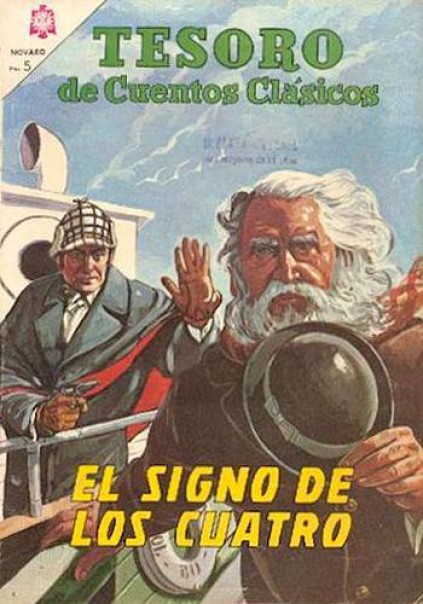 TESORO DE CUENTOS CLÁSICOS #92 TESORO DE CUENTOS CLÁSICOS #92Editorial Novaro / Mexico / Apr'65 " A Scandal In Bohemia" 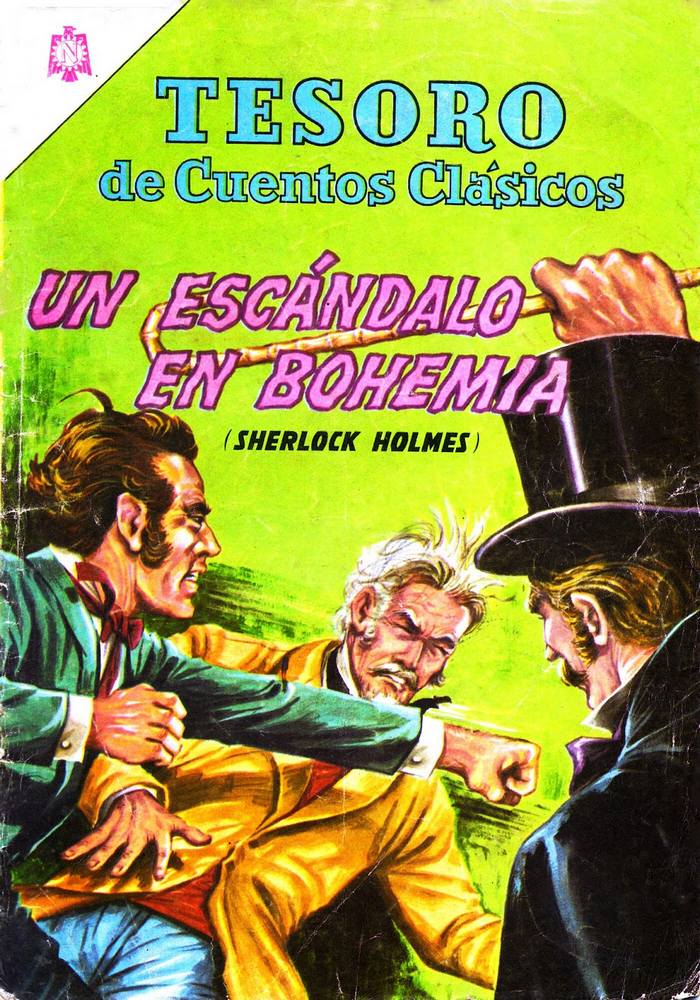 As far as I know, these are all done by Mexican writers & artists. The series began doing misc. "Classics" adaptations, then later focused on certain detective characters, and near the end of its run, became a horror book focused on stories about vampires-- all while maintaining a single tirle & numbering. It looks to me like after the first Holmes story, when they got back into it a few issues later, they started with the first 3 Doyle stories in sequence... but then stopped. In 1971, they began doing more Holmes stories, however, these later ones were brand-new stories, not adaptations!! They appeared in issues #161, 163, 166, 168, 172, 174, 176 and 182. |
|
|
|
Post by codystarbuck on Jun 29, 2019 18:34:34 GMT -5
Marvel Fanfare #50 Creative Team: Creative Team: Jo Duffy-writer, Joe Staton-Pencils, Joe Rubinstein-inks, Agustin Mas-letters, Petra Scotese-colors, Bob Harras & Al Milgrom-edits Yo, JOE! Seriously, 3 Joes. This was an inventory X-Factor issue. Milgrom's Editori-Al has him rifling Bob Harras' files for something to publish, in a desperate attempt to get material for the book and a sales boost from mutants. Probably the truest cartoon from Milgrom, I'll wager. Synopsis: Um.......yeah; not gonna spend a ton of time on this-framing story has Iceman and Beast tell Angel about a run-in with Arcade, who was hired by a woman to Kill Warren, for funding X-Factor and accidentally stirring up mutant hysteria. Angel is supposed to be dead, so Arcade agrees to kill 2 of X-Factor, instead and lures Beast and iceman to his Murder Maze, with a kid with wings...  They are led to believe the kid is Warren's illegitimate son; but, Warren, at the end, reveals the truth. He met the kid's crazy mother, at school, like she said; but, she married a dude who conducted nuclear experiments and grafted wings on his kid. He died of radiation poisoning and the kid has cancer. Warren had been paying for chemo; but, when he was dead, the payments stopped. he's starting them back up. The rest is a Mark badger portfolio of rather impressionistic pin-ups. Thoughts: Not much to say about this one. I only read the debut of X-Factor and thought the idea of X-Factor being mutant hunters, then secretly being the rescuers of mutants was a bit overly complex and not likely to work well. As Arcade points out, the fact that no one caught on to the coincidental appearances until later suggests the Marvel Universe is filled with morons. Staton's art is good, story is okay, but unspectacular and reminds me why I wasn't reading the X-books at this point (except Classic X-Men). Just really didn't grab me and this is no exception. How this book has survived to 50 issues is a mystery. It never really lived up to its stated goal and was a dumping ground from almost the start. The fact that we got pockets of fun is a tribute to Al Milgrom's perseverance. The fact that he couldn't get top talent suggests that Better pay rate was not the case. People weren't exactly jumping all over graphic novels, either. It seems like everyone decided that the money was in being on a regular series, where royalty payments more than made up any difference in page rate. Just an idea; no proof.
|
|







































